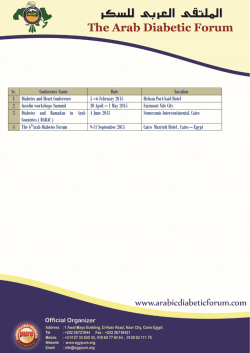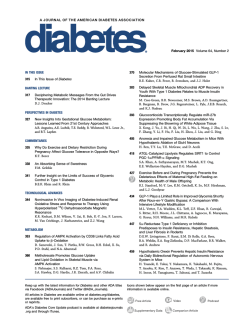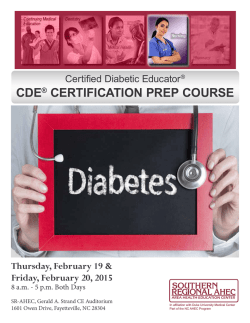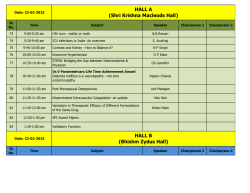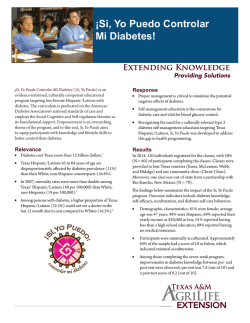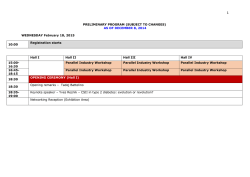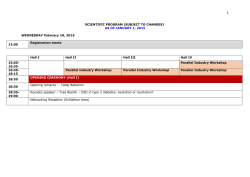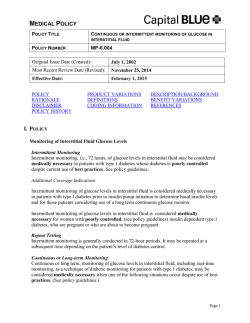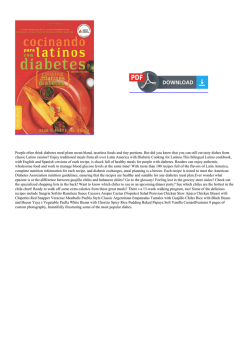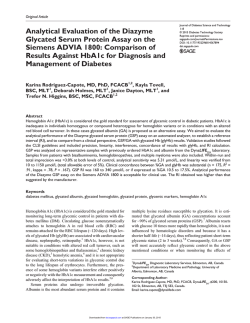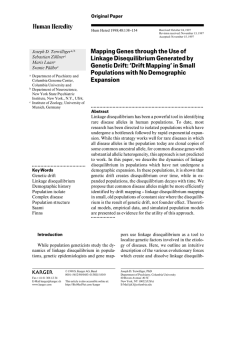
annotated bibliography - Institute for Patient- and Family
ANNOTATED BIBLIOGRAPHY Partnerships and Engagement in Care Ernst, A. (2013, May). Shared decision making: Engaging patients to improve health care. Washington, DC: Families USA. Available from http://familiesusa.org/library This report explores the process of shared decision-making and includes a discussion of the benefits, effective strategies that encourage patient and family participation in decisionmaking, and ideas for creating shared decision-making materials and tools Essential Hospitals Institute (2013, December). Facilitators and barriers to providing patientcentered chronic disease care to patient populations at risk for health and health care disparities in safety net settings. Washington, DC: Author. This report summarizes findings from a literature review and 70 interviews—60 with health care professionals and 10 with patients—from six organizations. The following five key characteristics of effective chronic care approaches for underserved communities are identified and discussed: communication tailored to vulnerable populations, team-based care, customized and personalized care, addressing special populations’ needs, and use of data and measurement. Specific challenges faced by safety net clinics such as staff and financial limitations and challenges experienced by patients such as co-morbidities and factors associated with poverty are noted. Hibbard, J., & Greene, J. (2013). What the evidence shows about patient activation: Better health outcomes and care experiences; Fewer data on costs. Health Affairs, 32(2), 207-214. Hibbard and Greene offer a review of the role of patient activation in patient engagement. They include studies that used the Patient Activation Measure. Their summary of the research conclude that patient activation levels can be increased with interventions and that patients who are more activated have better health outcomes and report more positive care experiences. Hibbard, J., & Minniti, M. (2012). An evidence-based approach to engaging patients. In D. Nash, J. Clarke, A. Skoufalos, & M. Horowitz (Eds.), Health Care Quality: The Clinician’s Primer (pp. 245-262). Tampa, FL: American College of Physician Executives. Koh, H. K., Brach, C., Harris, L. M., & Parchman, M. L. (2013). A proposed 'Health Literate Care Model' would constitute a systems approach to improving patients' engagement in care. Health Affairs, 32(2), 357-367. doi:10.1377/hlthaff.2012.1205 Page 1 of 4 In this article, the authors propose a framework for integrating best practices for improving health literacy into the six elements of the Chronic Care Model: health care organization, self-management support, delivery system design, decision support, clinical information systems, and community partners. Strategies for implementation and evaluation are included. Specific strategies are derived from the Health Literacy Universal Precautions Toolkit, that is available on the Agency for Healthcare Research and Quality website. Lubic, R. W., & Flynn, C. (2010). The Family Health and Birth Center: A nurse-midwife-managed center in Washington, DC. Alternative Therapies in Health and Medicine, 16(5), 58-60. The approach that this collaborative center serving women and families in a low income, underserved, urban community is discussed. Highlighted is its focus on broadening their services and partnering with community organizations to address the underlying social determinants of health. Philis-Tsimikas. A., & Gallo, L. C. (2014). Implementing community-based diabetes programs: The Scripps Whittier Diabetes Institute experience. Current Diabetes Reports, 14(2), 462. doi:10.1007/s11892-013-0462-0 This article describes how Project Dulce, a successful model of care for people with diabetes who are from underserved and culturally diverse communities (see the annotation of PhilisTsimikas et al., 2012 following) has been replicated in two different areas targeting 1.) women with gestational diabetes; and 2.) patients with diabetes who are transitioning from the hospital to home. The authors provide detail about what others can do to create similar programs in their community. Philis-Tsimikas, A., Gilmer, T. P., Schultz, J., Walker, C., Fortmann, A. L., & Gallo, L. (2012). Community-created programs: can they be the basis of innovative transformations in our health care practice? Implications from 15 years of testing, translating, and implementing community-based, culturally tailored diabetes management programs. Clinical Diabetes, 30(4), 4156-163. Project Dulce, a program established in 1997 in San Diego County, has had a consistent record of positive outcomes for people with diabetes who are from underserved and culturally diverse communities. Two key features of the model, nurse care management and peer-led education are outlined and results from studies conducted over several years are provided. Strategies for replicating this model are discussed. Page 2 of 4 Sandy, L. G., Tuckson, R. V., & Stevens, S. L. (2013). UnitedHealthcare experience illustrates how payers can enable patient engagement. Health Affairs, 32(8), 1440-5. doi:10.1377/hlthaff.2012.1082 UnitedHealthcare, a large national payer, has been using strategies from a variety of fields including data, technology, marketing to improve patient engagement and informed shared decision-making. While their efforts are relatively recent, they report positive effects such as increases in individuals’ self-management activities and rates of wellness visits and screenings. They briefly discuss how their lessons learned can be applied to Medicare and Medicaid programs. Sarkar, U., Piette, J. D., Gonzales, R., Lessler, D., Chew, L. D., Reilly, B.,…Schillinger, D. (2008). Preferences for self-management support: Findings from a survey of diabetes patients in safety-net health systems. Patient Education and Counseling, 70(1), 102-10. This study explored the perceived level of self-interest in three types of self-management support in patients with diabetes who received care in public hospitals. The three methods were telephone support, group visits, and Internet-based support. Associations with factors such as English language proficiency, health literacy, control of diabetes, and perception of benefits for improved communication with their health care providers were measured. The study found that most patients were interested in self-management support but preferences for the type of support varied depending on race and ethnicity and health literacy. Many patients believed that better communication with their providers would have a positive effect on their diabetes. Implications for application to health care practices serving underserved and diverse populations are discussed. Silow-Carroll, S., Alteras, T., & Stepnick, L. (2006). Patient-centered care for underserved populations: Definition and best practices. Washington, DC: Economic and Social Research Institute. Through a literature review, interviews, and case studies the authors developed this report outlining core components of patient-centered care for underserved communities, the infrastructure and processes that best supports this approach, the barriers encountered in the field, and how health care policy can promote improvements. Their findings document the need to systematically integrate elements into organizations who care for underserved populations such as use of data, patient and family involvement at the care level and in program and policy redesign, workforce development, and leadership commitment to patient-centered care. Although the report was published in 2006, the detailed recommendations and strategies are still relevant. Page 3 of 4 Simmons, L. A., Wolever, R. Q., Bechard, E. M., & Snyderman, R. (2014). Patient engagement as a risk factor in personalized health care: A systematic review of the literature on chronic disease. Genome Medicine, 6(2), 16. The authors defined patient engagement as “…(1) understanding the importance of taking an active role in one’s health; (2) having knowledge, skills, and confidence to manage health/chronic conditions; and (3) performing health-promoting behaviors.” Key to the discussion is how limited the research is that actually studies patient engagement given the interest in the field. While only 10 studies were included, relatively small, targeted interventions led to increases in patient engagement levels and higher levels of patient engagement were shown to be associated with positive health outcomes. While this review did not include discussion of the effects of differences in race, ethnicity, socioeconomic status, health literacy, and other factors, its description of patient engagement and effective strategies is helpful as efforts to fund and promote patient engagement expand. Thom, D. H., Ghorob, A., Hessler, D., De Vore, D., Chen, E., & Bodenheimer, T. A. (2013). Impact of peer health coaching on glycemic control in low-income patients with diabetes: A randomized controlled trial. Annals of Family Medicine, 11(2), 137-44. doi:10.1370/afm.1443 Study participants were diagnosed with diabetes and were receiving care in one of six San Francisco public health clinics. They were randomly assigned to peer coaching or usual care. Peer coaches received 36 hours of training (the curriculum is available online) and provided one-to-one coaching to patients in person and on the telephone. Patients who received peer coaching showed significantly lower HbA1C levels at 6 months. Page 4 of 4
© Copyright 2026
